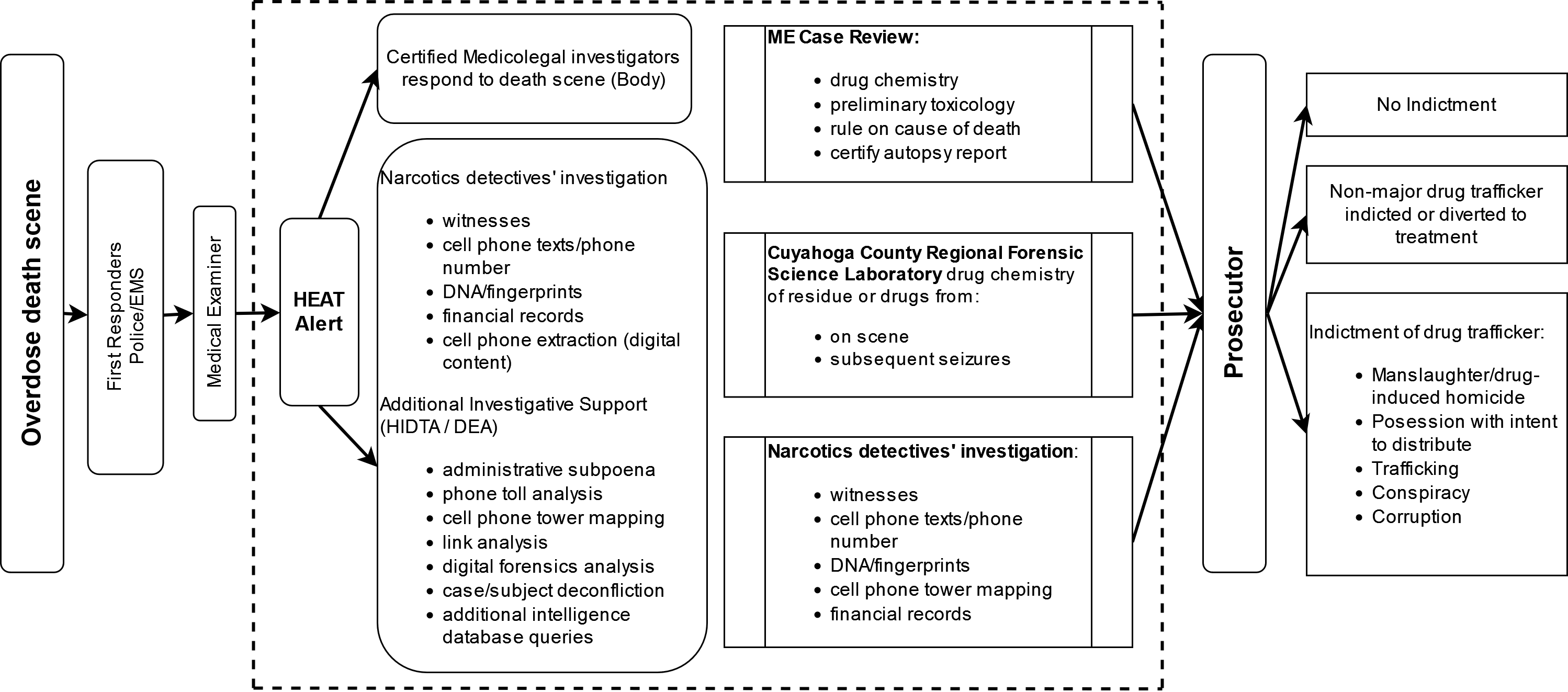An Examination of Cuyahoga County’s Heroin Involved Death Investigation (HIDI) Protocol
Cuyahoga County’s Medical Examiner’s Office developed the Heroin Involved Death Investigation (HIDI) Protocol to support a safe, coordinated, and rapid response to active drug overdose death scenes. Per the protocol, alerts are sent to law enforcement investigators if the medical examiner suspects a death is related to opioid use or overdose. These alerts notify law enforcement of potential dangers (e.g., lethal drugs) and facilitate protection of the scene and collection of evidence. Potential benefits of the HIDI Protocol include:
- Rapid identification of the drugs involved.
- Clarity of ‘but for cause’[3] of death.
- Potential links to the major drug trafficker who supplied the illegal substances.
Although it was originally developed to respond to fatal overdose incidents, HIDI alerts also support responses to non-fatal scenes. In these cases, information gathered may inform investigations and prosecutions.
Researchers at Case Western Reserve University Begun Center for Violence Prevention Research and Education received funding from NIJ to examine the HIDI Protocol and suggest possible improvements based on interviews with practitioner stakeholders. This research was conducted in collaboration with the Cuyahoga County Medical Examiner, the Cleveland Division of Police, the U.S. Attorney for the Northern District of Ohio, and the Cuyahoga County Prosecutor’s Office. The researchers found:
- A collaborative system for alerting investigators is essential to catching and prosecuting drug traffickers. This system should include standards for protecting, collecting, and processing evidence from overdose scenes.
- Information from medical examiner overdose death scene investigations should be easy to use and made available in digital data files. Investigators can then use the data to look for patterns that may allow them to draw connections between overdose victims, ‘but for cause’ of death, and drug suppliers.
- The information can be used to support investigations in Cuyahoga County. For example, investigators could highlight all deaths occurring at about the same time or where on-scene evidence includes the same type of paraphernalia, packaging, and/or drug.
- Information sharing across stakeholder entities – from emergency medical service, law enforcement, and medical examiner early responders to hospital and treatment providers and public health officials – facilitates not only successful prosecutions of major drug traffickers, but may also assist in identifying needed harm reduction and treatment opportunities to prevent fatal overdoses

Research Methods and Limitations
The research goals were to:
- Evaluate the implementation and perceived effectiveness of the HIDI protocol.
- Examine how fatal overdose cases move through the process from investigation to prosecution and explore how the process can be improved.
- Review medical examiner investigative reports to identify patterns or trends in demographics, geography, and paraphernalia and evidence present at death scenes to help prosecutors; identify key factors that contribute to the successful indictment of major drug traffickers connected to fatal and non-fatal overdose cases.
The researchers coded medicolegal overdose death investigation files (n=3261) from 2014 through 2019 for toxicology, victim demographics and history, and scene evidence. They also examined public records on federal (n=43) and state (n=78) drug-induced homicide or manslaughter cases identified by prosecutors for charges, outcome, and evidence used. They conducted interviews and focus groups between April 2018 and September 2021 with 54 staff who developed the HIDI protocol or were affected by the HIDI interagency network; those included medical examiner medicolegal investigators and other medical examiner’s office staff, police overdose death investigators, federal and county prosecutors, and other key stakeholders.
Limitations in medical examiner data include the secondary nature of family or witness reports of medical or behavioral health histories or the circumstances of the overdose. In addition, only publicly available prosecution files could be used due to COVID-19-related access restrictions. Finally, Cuyahoga County is primarily urban, so the qualitative findings from this study may not be generalizable to rural and tribal areas.
Conclusions
Overall, this project examined the HIDI Protocol and found it to be an innovative, collaborative system of data protection, collection, and flow that supports overdose investigations. In addition, the researchers identified several opportunities for improvement. The research team concluded that, with slight modifications, the HIDI Protocol could be implemented in other communities experiencing similar opioid overdose-related challenges. However, applications to other jurisdictions would need to consider potential risks and harms to individuals or groups and ethical considerations that may factor into use of the protocol. In addition, users should be aware of all relevant statutes, regulations, and/or governing judicial decisions (e.g., established case law, prevailing court rulings) related to the protocol’s use.
Research Work Products
- Infographic – The HIDI Protocol outlines the process for collecting overdose scene evidence and analyzing aggregate information across cases. This process combines medical examiner, forensics, and crime scene data to promote successful law enforcement and prosecution strategies.
- Summary Overview of the HIDI Protocol and Recommendations for Law Enforcement (16 pages) – This summary report describes the HIDI Protocol development and implementation guide for general field users and other stakeholders.
- Final Research Overview Report (221 pages) – This report provides a detailed description of the research project including methods, findings, and discussion of implications and caveats. Also included in this report are appendices that document the coding schemes used to extract information from medical examiner and prosecution case records and the instrumentation used to conduct interviews and focus groups with Cuyahoga County field users and other stakeholders.
About This Article
The work described in this article was supported by NIJ grant 2017-DN-BX-0168 awarded Case Western Reserve University.
This article is based on the grantee report, “Cuyahoga County, Ohio, Heroin and Crime Initiative: Informing the Investigation and Prosecution of Heroin-Related Overdose” (2022) by Daniel J. Flannery, Ph.D., Mark Fleisher, Ph.D., Karen Flynn, Ph.D., Michelle Riske-Morris, J.D., Ph.D., and Sarah Fulton, M.A.







